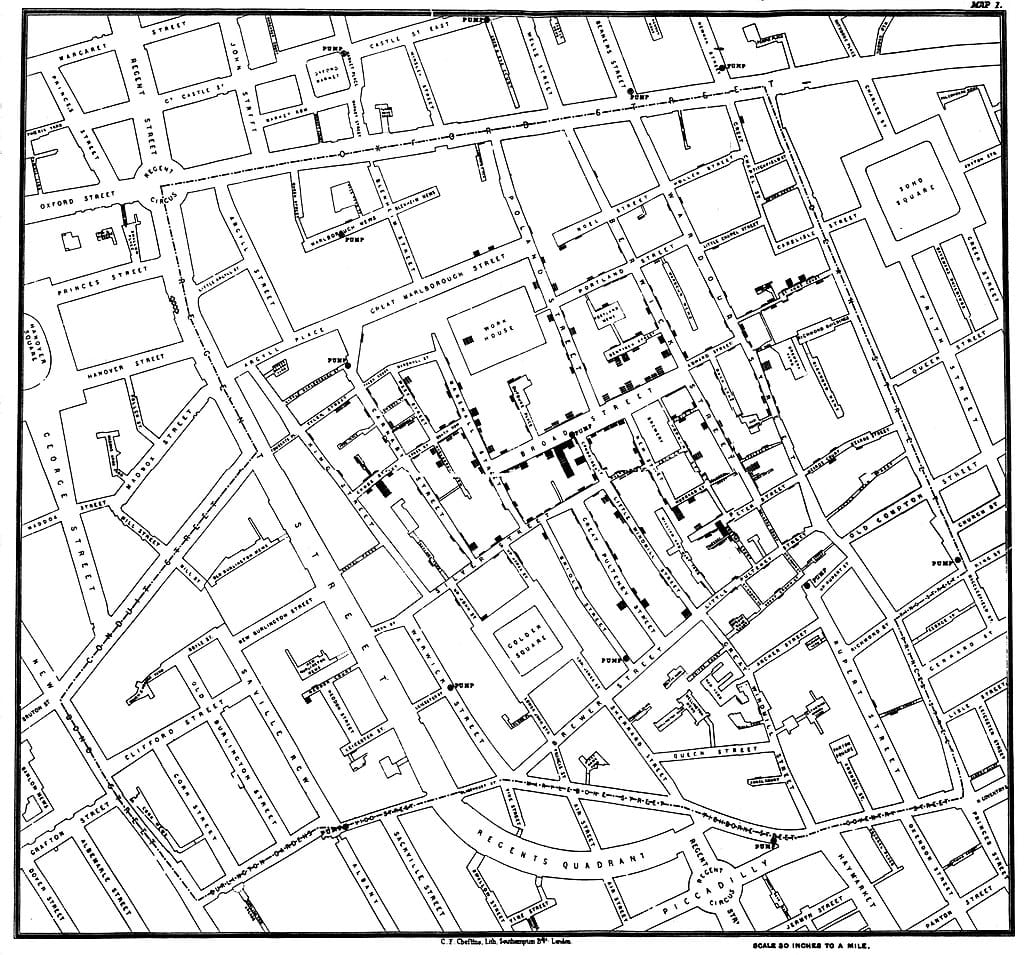The Ghost Map: dive into the 1854 London cholera outbreak

The setting of this book - a cholera outbreak in Victorian England revolving around cesspools contaminations - is not particularly the most attractive thing in the world, yet it’s fascinating to see the story behind how we came to understand that cholera is water-borne, how it established the base of epidemiology, how the public health and city planning system evolved, and how it made urban-living possible. There are many aspects to this cross-disciplinary case study that it’s difficult to string all my thoughts on it together.
The premise
It’s 1854. Enter the thriving, rising city of London with 2.5 million people in the cramped, underdeveloped Elizabethan infrastructure. With the population skyrocketing but without proper sewage system, residents at the time simply discarded of their wastes in cesspool, and following The Nuisances Removal and Diseases Prevention Act of 1846, into the river. Miasma theorists concluded that cholera was air-borne, caused by “miasma” particles spreading in air. Therefore legislations based upon that idea, originally meant to stop the spread of infectious diseases, ironically encouraged the disease we now know is water-borne. By late August and early September, the infamous Broad Street outbreak occurred, with over 10% of the population dying in the span of seven days - giving way to physician John Snow a chance to prove his germ theory with raw data.
The double-blind experiment and the data collection
Now looking back, it’s absolutely impressive that Snow seized the opportunity to utilize the event as an intersection between a natural experiment and an observational study to examine possible causes, since controlled experimentation was certainly not a viable option given technical limitations and ethical concerns. As with all observational studies, obtaining accurate, reliable information required tremendous effort. Fortunately, Snow recruited the help of Henry Whitehead, a local curate with access to information otherwise unavailable to Snow. Whitehead had the advantage of first hand experiences with the community members. As a result, he was able to acquire a diverse set of data, which enabled him to observe correlations between unusual factors. From there Snow drew the ghost map that shows clearly how concentrated the cholera cases were around a single source that is the contaminated water pump. It’s worth pointing out that this fits into the framework of a double-blind experiment, as neither the patients nor the investigators knew the true cause of cholera was, thus eliminating potential biases. In a traditional experiment, water supplies might be overlooked as a predictor, but in observational studies, all the confounding factors eventually steering clear and the true independent variable eventually coming to the surface. This mode of collaboration sets the foundation for modern day epidemiology, combining demographic study and scientific data.
How faulty ideas persist despite evidence
An idea that had personally intrigued me and appeared many times throughout Snow’s investigation was how the Miasma theory persisted despite the concrete evidence against it. Even before the outbreak in 1854, Snow grew skeptical of the theory, doubtful of how the same doctor who attended the infected patients during the infectious phase stayed free of cholera. Yet its proponents remained fiercely for the miasmatic theory to a point where their confirmation bias “blinded them to the patterns that Snow and Whitehead perceived so clearly”. In an attempt to test Snow’s findings, Hall’s team, the Board of Health Committee, failed to examine the factors resembling water consumption patterns and instead focused on those relating to miasma and sanitary conditions, which happened to be confounding factors. This is not the first story of one theory overthrowing another, but nevertheless the difficulties involved shows how stubborn the scientific community could be and the possibility of the right ideas out there waiting to be proven right.

A glimpse into alcohol in preventing cholera
Another aspect that stood out to me was the role alcohol played in the quest for the true cause of cholera. Historically, the solution to combat the lack of unpolluted water was through consumption of alcohol, as its antibacterial properties helped fight off waterborne diseases like dysentery. Before the arrival of coffee and tea, beer and wine domesticated “one microbial life-form in order to counter the threat posed by other microbes.” In many instances in the investigation of cholera, alcohol found its way back to the stage and later leading Snow to conclude that cholera was caused by the bacteria Vibrio cholerae.
The effects
Consider the effects of such an outbreak - not only the deaths, but also the chaos and the helplessness - and the idea that perhaps high-density living is not feasible, that a city may just collapse. Therefore identifying the contamination as the cause of the outbreak and proving that cholera is waterborne gave many a glimmer of hope and takes away that fear of urban-living.
Some final thoughts
His writing paints a vivid picture of Dickensian London, summarizes well a multidisciplinary case without overemphasizing on any aspect and adds colour to a subject that could be a little dry otherwise. This story, as author Steven Johnson puts it, of “a deadly bacterium, a vast city, and two gifted but very different men” is certainly a worthwhile read for those interested in learning a thing or two about history, statistics or public health.









